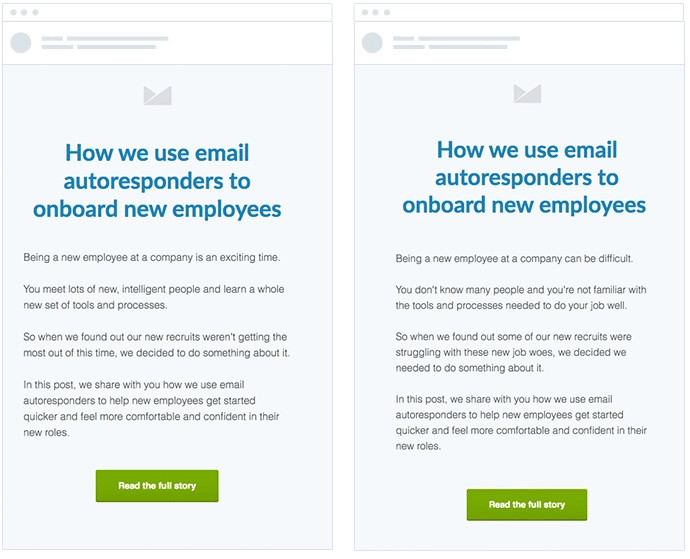Stale, boring email newsletters are all too common nowadays, and for a lot of the same reasons. Here are some of the most common email newsletter mistakes that marketers make.
For as long as brands have been using email to market to their audience, they’ve been using newsletters as a means of updating customers on their products, educating their audience, one of the other countless goals they might have.
Newsletters are so common these days, you might even say that they’re getting a bit…boring? This may sound blasphemous coming from someone working at an email marketing software company, but the truth is that there are a lot of bland, boring newsletters out there.
But how do you know if that’s you? How do you know if your newsletter is one of the ones getting deleted instead of getting read? And more importantly, how do you fix it?
Let’s take a look at some of the most common email newsletter mistakes, and what you can do to fix them.
Common newsletter mistakes
- You’re talking too much about yourself
- You’re pushing too hard for a sale
- You don’t have a goal in mind
- You’re not writing like a human
- You’re not segmenting your audience
- You aren’t A/B testing
- You’re not monitoring your results
#1: You’re talking too much about yourself
We can understand why you’d think a newsletter should primarily be about you or your business. It’s right there in the name, after all. But one of the most common newsletter mistakes marketers make is talking way too much about their business.
Here’s a little secret about newsletters that rings true for all of marketing: nobody wants to hear you talk about yourself or your company. People subscribe (and stay subscribed) because there’s something in it for them.
Think about the newsletters you enjoy reading — are they full of news about what that company had for Friday lunch together? Or are they full of helpful resources and content that appeal to your interests?
This isn’t to say you shouldn’t talk about yourself at all. The 90/10 rule is a good one to follow here. Spend 90+% of the time educating your audience with helpful resources, and no more than 10% talking about yourself.
#2: You’re pushing too hard for a sale
One way to rack up newsletter unsubscribes quickly is to do nothing but promote your own products.
Yes, email is the king of ROI, and ultimately, your goal is to grow your business, but your newsletter is not the place for direct, aggressive sales.
Your newsletter is a place to build your brand and gain the trust and respect of your audience. Like we mentioned in point #1, your aim should be to be helpful. By asserting yourself as an engaging, helpful resource, you’ll gain the trust of your audience, and earn the right down the road to talk business.
Newsletters are a long-term game about building your community and your brand, not direct profit.
#3: You don’t have a goal in mind
With each newsletter you send, it’s worth asking yourself “what is the goal of this email?” With that in mind, each email should have a very obvious action you want the reader to take. This is typically referred to as a call-to-action (CTA).
If you want the reader to click through to a blog post, you should make it easy by adding a button that clearly directs them. If you’d like for them to register for a webinar, clearly communicate that, and give them an easy way to register.
There are actually two ways brands frequently get this wrong. The first way is by not having any CTAs. Some (typically the “this is what we ate at our Friday lunch” crowd) will ramble on about something, without having a real reason why they’re in your inbox.
The second way people get this wrong is by having too many CTAs. If you’re including links to everything you’ve ever published on the internet, it’s going to leave people confused on what to click. And after you’ve successfully given them decision paralysis, they’re likely to just close your email altogether.
Narrow in on your goals, and you’re bound to see better results.
#4: You’re not writing like a human
This one is particularly true of brand or company newsletters — they forget to write like humans! Too many marketers write their newsletters in safe, bland language while hiding behind the brand name.
While people can sometimes feel connected to companies and products, they feel stronger connections with people. If you’re writing a newsletter, take ownership of it. Let people get to know the person writing the email.
Gigi Rosenberg, a public speaking coach and Campaign Monitor user, has great advice on this. She thinks of her newsletter as a party that she’s the host of — as opposed to social media, where she thinks of herself as more of an attendee.
“The people on my email list are my invited guests or my VIPs,” says Gigi. “Each month I share one public speaking tool with this group of my favorite people. It’s a way for me to offer something useful and stay in touch with this community.”
Watch Gigi’s video to learn more about how she makes her newsletter a personal, engaging experience.
#5: You’re not segmenting your audience
56% of people say they’ll unsubscribe from an email list if the content isn’t relevant to them. Yet marketers continue to send the same content to their entire list, hoping that people will be interested.
Your audience is full of individuals who all have different interests. To keep your content relevant and avoid unsubscribes, start thinking of ways to break up your list by personas. Segmenting your audiences by age, location, or profession can give you better ideas of what content to send them, and in turn, keep them engaged.
For more on segmentation and what it looks like in practice, make sure to check out our Guide to Segmentation in Marketing for the Evolving Marketer.
#6: You’re not A/B testing
A/B testing is an easy way to test different elements of your email and see what your audience prefers. A lot of brands neglect to do it, but those who do have seen big results.
We ran an A/B test a while back, simply testing the tone of an email. One email used positive language, while the other was designed to try and create a sense of urgency and gravity. Turns out, our audience is pretty positive. The email with the positive tone won with a 22% higher conversion rate.
Other things you can A/B test include:
- Subject lines
- Length of the email
- Content
- Images
- Personalization
- Template style
- CTA buttons
The options are endless really.
#7: You’re not monitoring your results
One last newsletter mistake that marketers make with their newsletters is that they don’t monitor their results. Reviewing your metrics after each campaign gives you invaluable insights into what kind of content your audience is responding to.
This allows you to understand your subscribers on a deeper level, and learn what preferences they have: if they prefer shorter or longer subject lines. Or if they like all-text emails as opposed to ones with images.
Monitoring your email metrics is key to your newsletter’s success.
Wrap up
There are a lot of bad email newsletters out there, but that shouldn’t discourage you from sending them! When done right, the newsletter has incredible power for building your brand and cultivating a sense of community amongst your audience.
Just make sure to avoid these common newsletter mistakes and you’ll do just fine.






